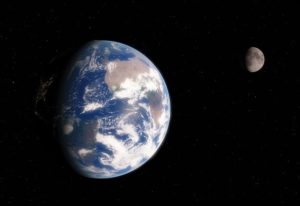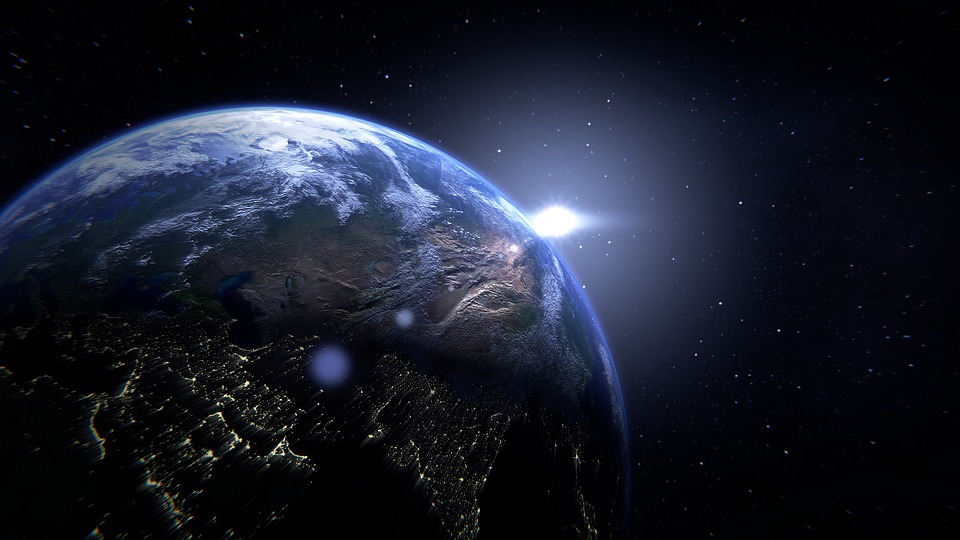 A new study has been issued from Oxford University that casts doubt on the notion that there is “intelligent” life in abundance elsewhere in the universe. More on that study in a moment.
A new study has been issued from Oxford University that casts doubt on the notion that there is “intelligent” life in abundance elsewhere in the universe. More on that study in a moment.
Meanwhile, I have written from time to time on the question of whether there is other intelligent life in the universe. As a Catholic, I have no need for the answer to be yes or no; the Church does not teach on this one way or another. Neither do the Scriptures address the point directly or make any scientific declaration.
Generally, however, my own conclusion is that intelligent life and highly developed civilizations, like or more advanced than our own, are rare and perhaps even non-existent. I based this on past study of the matter.
Some have balked at my conclusion; and that is fine, it is only my conclusion, and provisional at best. I would easily abandon the conclusion if new evidence presented itself. But I have also discovered that many people who assume that intelligent and highly organized civilizations are out there, hold their view for largely or merely statistical premises. The thinking goes: in a universe of a billion trillion stars, chances are high, almost certain, that such life is out there.
But statistics are a funny thing. Simply looking at the number of stars and galaxies, sounds expansive in terms of possibilities. But statistics can cut both ways. For it is not just one or two things that make life possible on earth; there are hundreds, even thousands of factors which make life, and especially developed and diverse life, stably possible on earth to the degree that complex and technological civilizations could emerge. Multiplying these many factors together brings the statistical possibilities of advanced life substantially down.
I have written more on these factors (sometimes called “Rare Earth” Hypothesis) here: Earth is a Rare Jewel. But the essential point of the theory is that there are many factors that have made life possible on earth by providing a stable setting for life to arise and develop. Here are just some of the many:
- Earth is at just the right distance from the Sun so that it is warm enough for ice to melt, but not so hot as to boil and steam away. Water is also able, in this habitable zone (the so-called “Goldilocks” region), to both evaporate and condense at lower levels in the atmosphere, thus permitting a more even distribution of water and the cycle of water over dry land known as precipitation.
- For suns to spawn Earth-like planets they must have sufficient “metallicity,” which is necessary for the formation of terrestrial rather than gaseous planets.
- Earth is in a “habitable zone” within the galaxy as well. Closer to the center of galaxies, radiation and the presence of wandering planetoids make life there unlikely.
- Earth exists in a disk-shaped spiral galaxy (the Milky Way) rather than in an elliptical (spheroid) galaxy. Spiral galaxies are thought to be the only type capable of supporting life.
- Earth’s orbit around the sun is an almost perfect circle rather than the more common “eccentric” (elongated) ellipse. Steep elliptical orbits take a planet relatively close to and then relatively far from the sun, with great consequences for warmth and light. Earth’s stable, nearly circular orbit around the sun keeps our distance from it relatively constant, and hence the amount of heat and light does not vary tremendously.
- Two nearby “gas giants” (Jupiter and Saturn) attract and catch many wandering asteroids and comets and generally keep them from hitting Earth. The asteroid belts also keep a lot of flying rock in a stable orbit and away from us.
- Our molten core creates a magnetic field that holds the Van Allen radiation belts in place. These belts protect Earth from the most harmful rays of the sun.
- Earth’s volcanism plays a role in generating our atmosphere and in cycling rich minerals widely.
- Our sun is just the right kind of star, putting out a fairly steady amount of energy. Other types of stars are more variable in their output and this variance can utterly destroy life or cause it to be unsustainable due to the extremes.
- Earth’s fairly rapid rotation reduces the daily variation in temperature. It also makes photosynthesis viable because there is enough sunlight all over the planet.
- Earth’s axis is tilted just enough relative to its orbital plane to allow seasonal variations that help complex life, but not so tilted as to make those variations too extreme.
- Our moon causes tides that are just strong enough to permit tidal zones (a great breeding ground for diverse life) but not so severe as to destroy life.
It would appear that for complex life to be sustained, many factors must come together in just the right way.
In June, a team of researchers at the University of Oxford released a paper that casts doubts (but does not rule out) that intelligent life is “out there” in abundance. Here is a recently published summary of their research:
In 1950, while working at Los Alamos National Laboratory, physicist Enrico Fermi famously exclaimed to his colleagues over lunch: “Where is everybody?”
 He had been pondering the surprising lack of evidence of other life outside of our planet. In a universe that had been around for some 14 billion years, and in that time developed more than a billion trillion stars, Fermi reasoned there simply must be other intelligent civilizations out there. So where are they?
He had been pondering the surprising lack of evidence of other life outside of our planet. In a universe that had been around for some 14 billion years, and in that time developed more than a billion trillion stars, Fermi reasoned there simply must be other intelligent civilizations out there. So where are they?
We still don’t know, and the Fermi paradox has only strengthened with time. Since the 1950s, humans have walked on the moon, sent a probe beyond our solar system, and even sent an electric sports car into orbit around the sun for fun. If we can go from rudimentary wooden tools to these feats of engineering in under a million years, surely there would have been ample opportunity in our 13.8 billion-year-old-universe for other civilizations to have progressed to a similar level—and far beyond—already?
And then, surely there would be some lingering radio signals or visual clues of their expansion reaching our telescopes. …
Now, a team of researchers at the University of Oxford brings a new perspective to this conundrum. In early June, Anders Sandberg, Eric Drexler, and Toby Ord of the Future of Humanity Institute (FHI) released a paper on the Fermi paradox—the discrepancy between our expected existence of alien signals and the universe’s apparent lack of them—once and for all.
Using fresh statistical methods, the paper re-asks the question “Are we alone?” and draws some groundbreaking conclusions: We Earthlings are not only likely to be the sole intelligence in the Milky Way, but there is about a 50 percent chance we are alone in the entire observable universe. …
Space is a large place, and the task of accurately estimating the likelihood of little green men isn’t exactly easy.
In 1961, astronomer Frank Drake proposed a formula that multiplied seven “parameters” together to estimate the number of detectable civilizations, N, we should expect within our galaxy at a given moment in time. …
The Drake equation was only intended as a rough tool to stimulate scientific discussion around the probability of extraterrestrial life. However, in the absence of any reasonable alternatives, it has remained astronomers’ only method of calculating the probability of extraterrestrial intelligence. This is problematic because while some parameters … are relatively well-known, others remain hugely uncertain. …
This enormous uncertainty leaves the Drake equation ultimately vulnerable to the optimism or pessimism of whoever wields it. And this is reflected in previous scientific papers whose results give values of N ranging anywhere from 10 to many billions. …
Sincere attempts to overcome this vulnerability have previously been made via selecting a handful of conservative, medium, and bullish best estimates for each parameter value and then taking an average across them.
In their new paper, titled “Dissolving the Fermi Paradox,” the FHI researchers dispute this method by demonstrating how this technique typically produces a value of N far higher than it should, creating the illusion of a paradox. …
[The researchers proposed a complex two-stage process of evaluating the Drake equation that] produced striking results: Based upon the current state of astrobiological knowledge, there’s a 53 to 99.6 percent chance we are the only civilization in this galaxy and a 39 to 85 percent chance we are the only one in the observable universe [*].
As you may imagine, there are many who find the conclusion of the authors problematic. I, too, wonder if their conclusion is too strong given the scientific method used. However, I still thing that Earth is a rare jewel! Indeed, there is something almost enchanted about our world.
Of this much I am happy: we are moving beyond simplistic theories that simply rely on the large size of the universe and its trillions of stars and looking more to the complex interactions required for life on Earth to exist as we know it. These are part of the statistical analysis we need to make as well, and they add a sober appreciation to what has made us what and who we are.
From a religious standpoint, my response to the details that make life on Earth what it is, are wonder and awe. The more we learn, the more we should be amazed; life is indeed a great mystery! As a believer, I am grateful to God and amazed at the subtle complexity of what He does. Our life here is not a common thing. It appears to be carefully, subtly, and consistently fostered and guarded. Earth is not common. It is quite special—perhaps even unique.


How arrogant to assume that the universe is here just to produce us as the end goal. No matter how rare or common it is for intelligent life to arise, there is no special reason about why Earth and the universe are as they are. It is not proof enough that we’re here, because if we weren’t we wouldn’t observe the qualities that do make Earth suitable for life. You shouldn’t draw conclusions from a sample size of one.
The adjective “arrogant” has missed its target.
I read the blog carefully and everything started with a reference to a study by Oxford University, with a long summary of that research. I also found a clear reference to the teachings of the Catholic Church on the matter of intelligent life in the universe: “The Church does not teach on this one way or another. Neither do Scriptures address the point directly or make any scientific declaration.”
The rest is Monsignor Pope’s opinion, to which he is entitled after all. He frequently uses qualifiers in his opinions, such as “perhaps” (several times), and “it would appear” and “I, too, wonder,” and “The statistical analysis we need to make….” He also points out that his conclusion is “provisional at best” and that he “would easily abandon [his] conclusion if new evidence presented itself.” May we all be so humble in our opinions.
I think this reply is fabulous! Thank you for being so clear.
The Earth is flat and unmoving. Measure by lasers and/or with a gyro.
He didn’t assume, he concluded. A big difference.
100 billion stars and we are the only intelligent life? Though I’m not a believer, I have a hard time believing that a god who created everything, decided to stop with the creation of our pathetic little planet and the even more pathetic humans that occupy it.
And a billion monkeys on keyboards will eventually type Shakespeare’s Hamlet.
Except that computer simulations of that hypothetical have shown that even getting through the first line of the “To be or not to be” soliloquy is near impossible.
Yes, it is an attractive thought that the mere force of the numbers would suggest abundant life throughout the universe. But actually, the numbers are quite small, as Monsignor shows. For life to exist here as the result of random chance would be like hitting the Lotto every day for 100 years — possible yes, but highly improbable. Add in to that the complexity of a single strand of DNA.
Although your statement is really an attempt to put God to the test, it and the science really do demonstrate to a rather high if not infinite probability that the universe, life, and particularly intelligent life are NOT the result of arbitrary, irrational random chance, but truly are purposely created.
Ha, ha, ha. I just looked up “infinite monkey theorem” on Wikipedia and the story tells of an attempt to try it with real monkeys.
And the monkeys . . . well, they did what monkeys do. Ha, ha. Laugh out loud funny.
I am reminded of 2 quotes:
“GOD may be subtle, but malicious HE is not.”
Johann von Goethe
“Nevee confuse claims or activities with net measurable replicable results.”
Richard Feynman
Cuban-American astrophysicist Guillermo Gonzalez made a similar argument, based on his scientific knowledge, in his 2004 book, The Privileged Planet — and he lost his tenured university position because his theory seemed to support religious ideas. As far as I can recall, Gonzalez makes NO religious claims in the book — just scientific evidence and reasonable conclusions based on available data. In other words, he did what scientists are supposed to do. Unfortunately, too many powerful people seem to believe that science’s purpose is to disprove religious belief whenever possible.
Here’s Gonzalez’s book, for anyone interested: http://a.co/dtWkWG5
Fine article! I’ve said much the same in ESSAY 4 of my web-book (linked at my name), “Are we special? The Anthropic Coincidences” (see https://scienceandthechurch.catholicscientist.com/home/are-we-special-the-anthropic-principle/).
This essay includes not only the cosmological and geological anthropic coincidences, listed in the article, but those in chemistry and molecular biology that enable carbon-based life.
It is a mistake, however, to apply conventional probability methods to the existence of these Anthropic coincidences. They are not independent events and the universe is a single datum. For example, consider all the properties of water that enable climate and life; consider all the remarkable properties of molecular biology. All these rely on the property of the hydrogen bond and that in turn comes about from fundamental physics, quantum mechanics and electrostatics. It is a grand blueprint made up by God, and I’m not talking about Intelligent Design as a scientific theory (it isn’t!)
Fine article! I’ve said much the same in “ESSAY 4, Are We Special—The Anthropic Coincidences” in my web-book, “Truth Cannot Contradict Truth.” However, it is a mistake to apply conventional probabilistic measures to such events—they’re not independent, and the universe is a single datum, not one among many in a sample of universes (no multiverse!)
For example, if one considers the properties of H2O and the remarkable properties of proteins and nucleic acids (DNA) that enable a life-supporting climate and molecular biology, one sees that these are due to the properties of hydrogen bonds, and hydrogen-bonding is, in turn, a consequence of quantum mechanics and electrical force laws. So how do you compute a probability for quantum mechanics?
One can only be amazed at the way everything hangs together, and repeat Psalm 19A, “The heavens declare the Glory of God.”
From what I’ve learned about God, I think it is possible that He created the universe to give us a hint at how “big” He is and how special our pathetic little planet and the even more pathetic humans that occupy it are to Him. That’s hard to believe, but not any harder than believing that life has randomly evolved out of rocks and radiation on thousands of other planets in the universe.
If life is so unlikely, why are we here? If we are here because of the choice of a divine being, then the statistical chances of life somewhere else has little to do with whether such like is or is not.
The evidence suggests, no evidence for life ‘out there’. I’m not an Astronomer nor an Astrophysicist but from the little I know, it seems the Cosmos we can observe is inimical to life. Nothing out there comes close to this amazing, beautiful planet we are blessed to inhabit.
Well written and something to contemplate. The universe is vast and despite our scientific advancements and increase in knowledge, our view is narrow and our understanding very limited.
The latest news (in summary):
1. The theory of evolution is wrong.
2. Einstein’s theories of relativlety (both the special and the general) are wrong.
3. The earth does nor rotate around the sun, but the sun and the entire unverse, rotate about the earth. The earth is immobile.
God created the earth as the centre of the universe for the wonderment and often bewilderment of every human being he creates. (Note: God creates a soul in every human being at conception/fertilisation and when the soul leaves the body then the body is dead, is judged, and then goes to heaven,(likely after some time in purgatory), or hell. Like it or not, that seems the be the reality for those open to the realities of our existence.
For further study I refer to Sr. Wolfgang Smith’s writing.